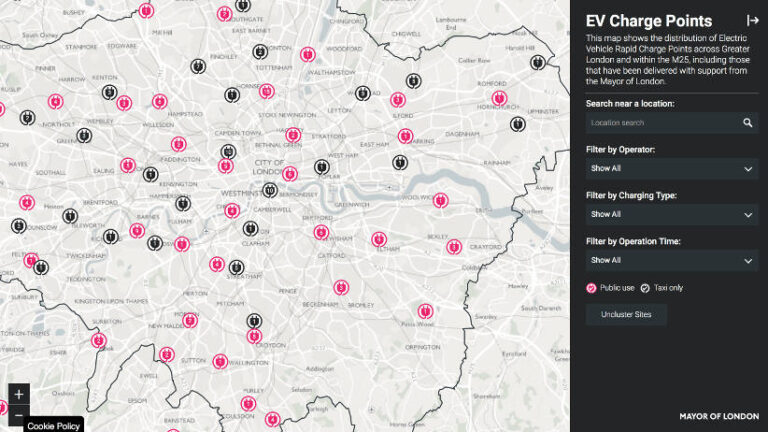Launched in 2018, the Mayor’s Electric Vehicle Infrastructure Taskforce is the first body of its kind, established with the goal of understanding London’s likely future EV infrastructure needs.
A map of London’s EV charging points can be found here:https://maps.london.gov.uk/ev-chargepoints/
The full delivery plan can be found here:http://www.tfl.gov.uk/ev-charging-plan
Representatives from the following organisations are on the Taskforce and they have been working together through discussions chaired by Deputy Mayor for the Environment and Energy Shirley Rodrigues:
- British Electrotechnical and Allied Manufacturers Association (BEAMA)
- Cross River Partnership
- Energy UK
- Federation of Small Businesses
- Freight Transport Association
- London Councils
- London First
- Office for Low Emission Vehicles
- Ofgem
- RAC Foundation
- Royal Institute of Chartered Surveyors
- Society for Motor Manufacturers and Traders (SMMT)
- Shell UK
- SSE Enterprise
- UK Power Networks
The first wave of private sector commitments supporting the plan include:
- DPD will open eight all-electric micro depots in London
- GeniePoint will install 17 rapid charge points at Morrisons supermarkets in London by the end of 2019
- Source London will install 100 fast 22kw chargers in central London by the end of 2020
- BP Chargemaster will install at least 20 ultra-rapid chargers on 10 BP forecourts in London by the end of 2021
- Addison Lee aim to have a zero-emissions capable fleet by 2022
- Uber aim for all cars using its app in London to be electric in 2025
- DriveNow aim for 50 per cent of their fleet to be electric by 2025
- Zipcar aim for 100 per cent of their fleet to be electric by 2025.
The delivery plan includes an estimate on the required number of chargers required in future scenarios. These estimates are based on the relationship between the preferred way in which people will charge their vehicles (e.g overnight or rapid) and the potential number of electric vehicles on London’s streets.
- By 2020, London could require 200 to 400 rapid charge points and 3,400 to 4,700 slow to fast charge points in a prudent EV uptake scenario, based on an estimate of 45,000 electric vehicles.
- By 2025, with EV uptake in line with the Mayor’s Transport Strategy and our 1.5 degree climate change plan, this could rise to a requirement for between 2,300 – 4,100 rapid charge points and between 33,700 – 47,500 slow to fast charge points, based on an estimate of 330,000 electric vehicles.
The taskforce members are confident the current delivery schedule in London by the private and public sector, consisting of over 300 rapid charge points and over 3,500 slow to fast charge points by the end of 2020 will be adequate to meet London’s needs. However, more ambitious action will be required by the public and private sector to ensure London has the charging infrastructure it needs by 2025.
London’s public services including TfL, the Metropolitan Police Service and the London Fire Brigade are already committed to transitioning to electric fleets by working towards:
- All cars support fleets being zero emission capable by 2025
- All new cars and vans (less than 3.5 tonnes), including response vehicles, being zero emission capable from 2025
- All heavy vehicles (greater than 3.5 tonnes) being fossil fuel-free from 2030






